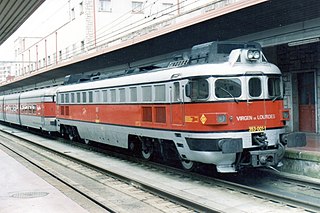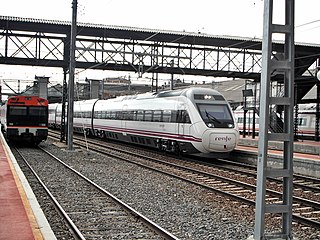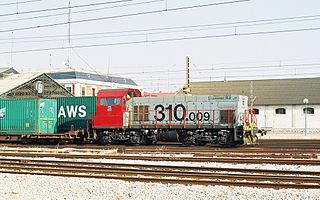
The Stadler Euro is a class of diesel-electric locomotives built by Stadler Rail for the European market. It is available in two basic variants, the four-axle Euro 3000, and the six-axle Euro 4000. These locomotives are powered by EMD 710 prime movers. A six-axle electric-only variant is marketed as Euro 6000; it is also built for the Iberian gauge.

The Renfe 334 is a high speed, 4 axle diesel-electric locomotive built to haul passenger trains on Renfe's Talgo service on non electrified lines.

The Renfe Series 333 are high power six-axle diesel-electric locomotives built in the 1970s; at the time of their introduction they were the most powerful non-electric locomotives in Spain.

The Class 340 of Renfe were a class of 4-axle diesel-hydraulic locomotives built by Krauss-Maffei for the Spanish Railways. The design is similar in outward appearance and technology to the DB Class V 200. 32 units were built.

The Renfe Class 353, formerly known as the T-3000 are a class of diesel-hydraulic locomotives built by Krauss-Maffei for express trains in Spain.

The Renfe Class 352 was a class of twin engined four axle diesel-hydraulic locomotives built by Krauss-Maffei, designed solely for passenger traffic; in particular they were responsible for towing Andalusian Talgo III trains. The class were very successful, heralding a new era of passenger trains in Spain. They were delivered in 1964 and 1965, and were fully withdrawn during the 1990s.
Stadler Rail Valencia SAU is a Spanish company, mainly producing products for the railway industry, subsidiary of Stadler Rail.

The Renfe Class 354 was a series of eight diesel hydraulic locomotives manufactured by Krauss-Maffei in Germany specifically to pull Talgo pendular coaches which were introduced shortly before the acquisition of these machines.

The Renfe Class 120 are electric multiple units used on Alvia high-speed rail services in Spain.

The Renfe Class 252 are a series of Bo'Bo' electric locomotives, built by CAF, Meinfesa, Siemens and Krauss-Maffei for RENFE. 15 units were built for the AVE Madrid–Seville high speed line in, and 60 units constructed for general use to Iberian gauge (1668mm).

The Renfe classes 319.2, 319.3 and 319.4 are six axle Co'Co' medium power mainline diesel-electric locomotives manufactured by Macosa using General Motors Electromotive division components under license.

The 254 Series is a meter gauge freight diesel locomotive built for Ferrocarrils de la Generalitat de Catalunya (FGC).
The Renfe Class 319 is a series of mainline diesel engined locomotives utilising EMD engines built for Spanish state railway company Renfe between the 1960s and 1990s.

The Renfe Class 309 is a class of 20 three axle diesel-hydraulic locomotives shunters built by M.T.M. for Renfe, and introduced between 1986-7.

The Renfe Class 310 is a class of 60 four axle Bo'Bo' diesel-electric locomotives for shunting and freight built by Meinfesa with General Motors Electromotive Division components.

The Renfe Class 311 is a class of four axle Bo'Bo' diesel electric shunting and light freight locomotives.

The ALCO RSD-39 was a six axle, low axle weight diesel-electric locomotive built by ALCO and under license by Euskalduna.

The Renfe 313 was a class of 6 axle mainline diesel-electric locomotives built for Renfe by Euskalduna under license from Alco. 50 units were built in the mid-1960s, locomotives surplus to Renfe's requirements were sold to Comboios de Portugal (CP), Trenes de Buenos Aires, Argentina, and to the railway company of Minero Siderúrgica de Ponferrada.

The Renfe Class 269 is a class of electric locomotives operated by Renfe in Spain. They were built by CAF and Macosa under license from Mitsubishi.

The Renfe Class 321 is a class of diesel-electric locomotives operated by Renfe in Spain, designed by Alco and built by them and by Euskalduna under licence.


















